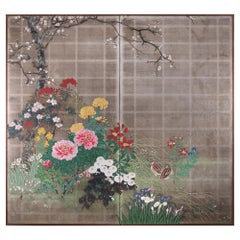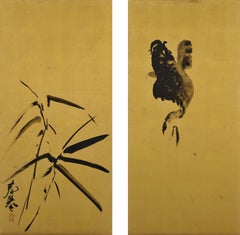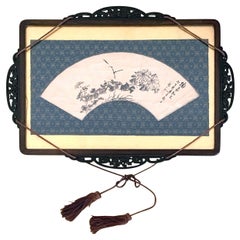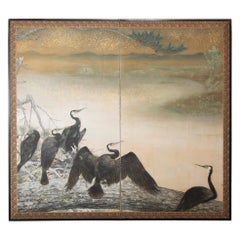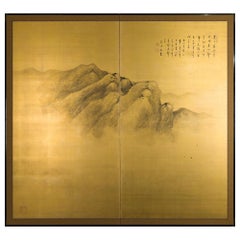Japanese Paintings and Screens
to
135
485
182
877
47
1
23
9
1
120
353
404
48
180
79
20
25
3
23
10
1
5
14
10
2
496
486
426
330
319
1,597
1,426
925
447
132
925
922
923
29
3
2
2
1
Place of Origin: Japanese
Japanese Two Panel Screen Summer Garden on Silver
Located in Hudson, NY
Flowers including peonies, dahlias, irises, and bellflowers bloom underneath a blossoming cherry tree and provide cover for a pair of quail. The structure of this garden almost resem...
Category
Early 20th Century Japanese Paintings and Screens
Materials
Silver Leaf
Yamamoto Shunkyo (1871-1933) Japanese Framed Painting Pair, Carp and Bamboo
Located in Kyoto, JP
Two framed panels by Yamamoto Shunkyo depicting a carp (koi) leaping from a river.
Ink and gold leaf on paper.
Instinctively brushed in a freehand s...
Category
Early 20th Century Meiji Japanese Paintings and Screens
Materials
Gold Leaf
Framed Japanese Ink Painting Hidaka Tetsuo
By Hidaka Tetsuo
Located in Atlanta, GA
An ink painting on the fan surface by Japanese Zen artist Hidaka Tetsuo (1791-1871), now framed in a traditional Japanese carved wood frame with silk fabric mat and decorative hangin...
Category
1850s Japonisme Antique Japanese Paintings and Screens
Materials
Wood, Paper
Taisho Period Painted Silk Screen Depicting Nesting Cormorants by Asami Joujou
Located in Stamford, CT
An exquisite Taisho period screen depicting nesting cormorants painted on raw silk with gold fleck by Japanese artist Asami Joujou (b. 1890 in Himeiji, Japan-d. 1974), circa 1912-1926.
Category
1920s Taisho Vintage Japanese Paintings and Screens
Materials
Silk
Japanese Two Panel Screen: Mountains in the Mist
Located in Hudson, NY
Chinese School landscape ink painting on gilded silk by Yukimatsu Shunpo, signed and dated 1924. Yukimatsu Shunpo was born in Oita in 1897 and studied under Himejima Chikugai in Osak...
Category
Early 20th Century Taisho Japanese Paintings and Screens
Materials
Silk
Japanese Two-Panel Screen Pink and White Magnolias in Early Bloom
Located in Hudson, NY
Japanese two-panel screen: Pink and white magnolias in early bloom, Taisho period (1912-1926) painting of Japanese magnolia tree branches as the flowers...
Category
1920s Taisho Vintage Japanese Paintings and Screens
Materials
Silk, Wood, Paper
An old couple (in Venice) by Blue Tip Atelier
Located in Sammu-shi, Chiba
Title : An old couple (in Venice)
Japan / 2024s
Size : w1960 x h2000 mm
While traveling in Venice, I came across an elderly couple sitting on a bench and was so inspired by their...
Category
2010s Modern Japanese Paintings and Screens
Materials
Linen
Japanese Two Panel Screen Aviary Shaded by A Maple Tree
Located in Hudson, NY
Japanese Two Panel Screen: Aviary Shaded By A Maple Tree, Showa period (1926 - 1989) painting of an outdoor bird enclosure under a maple tree. Painted in ...
Category
Mid-20th Century Showa Japanese Paintings and Screens
Materials
Silk, Wood, Paper
Vintage kimono textile art "Marble Story ~ Healing ~" by ikasu Grey, Japan
By Kimono ikasu
Located in Setagaya City, JP
This work uses a vintage kimono fabric with marble pattern, that makes it look like a real piece of marble.
The line in the middle symbolizes “kintsugi” - concept of wabi-sabi, which values imperfection, impermanence, and the beauty of aging.
It is elegantly framed with paulownia wood originally used for kimono chest-of-drawers, and is filled with storytelling and sense of luxury.
I used pieces of kimono that could no longer be used as clothing and kiritansu chest-of-drawers that would normally be discarded to create the ultimate upcycled piece.
<< Explanation and meaning of pattern and colors >>
Kintsugi (金継ぎ), which translates to "golden joinery" or "golden repair," is a traditional Japanese art form of repairing broken pottery with lacquer mixed with powdered gold, silver, or platinum. I used this tecnique here to "repair" antique kimono by transforming it into art work. Beyond its literal meaning of mending broken ceramics, kintsugi carries profound philosophical and cultural significance in Japanese tradition:
・Embracing Imperfection: Kintsugi celebrates imperfection and impermanence. Rather than disguising or concealing flaws, it highlights them, treating the breakage as part of the object's history. This philosophy encourages acceptance of imperfection as an essential aspect of life, beauty, and human experience.
・Wabi-Sabi Aesthetic: Kintsugi embodies the principles of wabi-sabi, an aesthetic worldview centered on the acceptance of transience and imperfection. Wabi-sabi values simplicity, authenticity, and the beauty of things that are imperfect, impermanent, and incomplete. Kintsugi exemplifies these principles by turning what might be considered flaws into features that enhance the object's beauty and character.
・Resilience and Transformation: The act of repairing broken things with precious metals symbolizes resilience and transformation. Instead of discarding or replacing the broken object, kintsugi honors its history and transforms it into something new and valuable. This reflects broader philosophical themes of overcoming adversity, finding beauty in imperfection, and embracing change.
・Honoring the Past: Kintsugi preserves and honors the history of the object. Rather than erasing or ignoring its past, it acknowledges and celebrates it. This aspect of kintsugi can be seen as a metaphor for honoring our own personal histories, including the challenges and setbacks we have faced, and recognizing how they have shaped us into who we are today.
・Spiritual and Philosophical Symbolism: Kintsugi has spiritual and philosophical implications, reflecting concepts such as the interconnectedness of all things, the cycle of life and death, and the pursuit of harmony and balance. The process of repairing broken objects with precious metals is seen as a metaphor for spiritual growth, enlightenment, and the journey towards wholeness.
Overall, kintsugi represents not only a practical technique for repairing ceramics but also a profound philosophical and cultural perspective on life, beauty, and the human experience. It embodies values such as resilience, acceptance, and the transformative power of embracing imperfection.
<< Characteristics of the fabric >>
This vintage textile is hand-painted with a traditional painting technique where the colors are added on wet surface, which creates an effect of marble.
<< About the frame >>
Kiritansu - chest-of-drawers for kimono, is traditionally made from paulownia wood, a uniquely Japanese material closely tied to the world of kimonos.
Paulownia wood is known as the lightest wood in Japan, prased for its natural luster, resistance to moisture, and resilience against cracking. Since ancient times, it has been used in crafting furniture, chests, and musical instruments.
During the Edo period, it became customary to store cherished kimonos in paulownia chests...
Category
1960s Japonisme Vintage Japanese Paintings and Screens
Materials
Gold Leaf
Japanese Six-Panel Screen "Wild Grasses and Peonies by Rivers Edge"
Located in Hudson, NY
Japanese Six Panel Screen: Wild Grasses and Peonies by Rivers Edge. Early Meiji period (1868 - 1912) painting of a grassy knoll next to a running brook or river. A soft breeze is m...
Category
1880s Meiji Antique Japanese Paintings and Screens
Materials
Gold Leaf
Japanese Rare Antique Scroll of Waka Heart Poem Famous Rengetsu Otagaki, signed
Located in South Burlington, VT
Japan, a rare paper scroll hand painted by renown Rengetsu Otagaki (1791-1875). She was a very famous nun in old Japan and being familiar with poetry, her Waka poems on paper, and e...
Category
Late 19th Century Edo Antique Japanese Paintings and Screens
Materials
Paper
$1,600 Sale Price
20% Off
Japanese Six-Panel Screen, Chrysanthemums and Twig Fence With Gold Flakes
Located in Hudson, NY
Rimpa School painting in mineral pigments with gofun and gold flakes on mulberry paper with a silk brocade border.
Category
19th Century Antique Japanese Paintings and Screens
Materials
Gold
Japanese Six Panel Screen, "Amorous Pheasants in Venerable Garden Pine"
Located in Hudson, NY
In a garden landscape with vibrant red camellias on a natural garden stone sculpture, mineral pigments and silver dust on mulberry paper.
Category
19th Century Antique Japanese Paintings and Screens
Meiji Period Japanese Four Panel Screen Bijin At Leisure
Located in Hudson, NY
Japanese four panel screen: Bijin At Leisure. Ladies in a tea house with a small dog. Seal reads "Ensan dai" (drawn by Ensan). Meiji Period (1868 - 1912) pa...
Category
Late 19th Century Meiji Antique Japanese Paintings and Screens
Materials
Silk, Wood
Japanese Four Panel Screen: Dancing Figures
Located in Hudson, NY
People dressed in ceremonial robes and masks celebrate the New Year. On New Year's eve a traditional Japanese custom is to ward off evil spirits by pretending to chase away people w...
Category
20th Century Japanese Paintings and Screens
Materials
Gold, Gold Leaf
MIEKO - Vintage Asian Style Painting on Paper - Signed - Japan - Late 20th C.
Located in Chatham, ON
MIEKO - Vintage Asian style painting on watercolor paper - signed with the artist's chop mark and name - Japan - late 20th century.
Excellent vintage condition - bleed through to th...
Category
Late 20th Century Anglo-Japanese Japanese Paintings and Screens
Materials
Paint, Paper
Pair of Japanese Two Panel Screens Rabbits and Geese in Autumn
Located in Hudson, NY
Screen A: Autumn Scene with Geese in a Gentle Landscape. Lovely painting depicting geese under maple, in a gentle water landscape. Mineral pigments on paper with gold leaf clouds.
...
Category
Late 19th Century Antique Japanese Paintings and Screens
Materials
Paint
Japanese Two-Panel Screen: Ink Landscape on Silk
By Shunyu
Located in Hudson, NY
Japanese Two Panel Screen: Ink Landscape on Silk, Meiji period (1868 - 1912) painting of a man riding a mule on a pathway through the Kurotani mountains with a thatched roof shelter ...
Category
19th Century Meiji Antique Japanese Paintings and Screens
Materials
Silk, Wood
Pair of Japanese hinagata byôbu 雛形屏風 (small folding screens) with flower carts
Located in Amsterdam, NL
An amazing pair of six-panel hinagata byôbu (doll festival folding screens) with a continuous painting on gold leaf showcasing flower carts (hana’guruma) at the edge of a winding river.
Both laden with a large bamboo basket...
Category
Early 19th Century Antique Japanese Paintings and Screens
Materials
Gold Leaf
Japanese Six Panel Screen: Karako 'Chinese Children'
Located in Hudson, NY
Children at play in a Chinese palace garden, a favorite subject of Japanese painters. Kano School painting in mineral pigments on mulberry paper with si...
Category
18th Century Antique Japanese Paintings and Screens
Materials
Bronze
Japanese Six Panel Screen: Hawk with Ancient Pine Overlooking Twig Fence
Located in Hudson, NY
Beautiful and dramatic Kano school painting of a hawk perched on a rock. With flowering cherry, peonies, pine and bamboo. Twig fence on the right is made of heavily oxidized silver...
Category
18th Century Antique Japanese Paintings and Screens
Materials
Gold Leaf, Silver Leaf
Japanese Two Panel Screen, Turkeys
Located in Hudson, NY
Mineral pigments on silk, mounted on a gold panel, in silk border. Signature and seal read: Yoho.
Category
Early 20th Century Japanese Paintings and Screens
Materials
Silk
Japanese Two Panel Screen: Mountain Landscape With Cedar and Pine on Gold Leaf
Located in Hudson, NY
Kano School painting, reminiscent of early Kano School paintings, in sumi (ink) and minimal pigments on gold leaf with a silk brocade border.
Category
Early 19th Century Antique Japanese Paintings and Screens
Materials
Gold Leaf
Japanese 17th Century Two Panel Screen, Pine with Gold Dust
Located in Hudson, NY
Beautiful 17th century painting of pine trees. Painting in good condition on 19th century mounting. Mineral pigments and gold dust on mulberry paper w...
Category
17th Century Edo Antique Japanese Paintings and Screens
Materials
Paper
Early 20th c. scroll depicting birds flying over the waves
Located in Fukuoka, JP
Unique signed Hanging Scroll depicting birds flying over the waves.
Age: First half of the 20th century
Size: Overall 203/64.5cm ( 79.8 / 25.3inch ) , only painting part:117/50....
Category
Early 20th Century Taisho Japanese Paintings and Screens
Materials
Wood, Paper
Japanese Asian Edo Period Signed Framed Hand Painted Serpent Scroll Painting
Located in Studio City, CA
A beautiful and striking framed Japanese/ Asian serpent/snake scroll painting featuring two serpents/snakes in a garden landscape surrounded by blossoming ...
Category
18th Century Antique Japanese Paintings and Screens
Materials
Wood, Paint, Paper
Unpei Kameyama, 'a View of Black 'American' Ships in the Bay of Uraga Senminato'
Located in Amsterdam, NL
Unpei Kameyama (1821-1899)
A view of black (American) ships in the bay of Uraga Senminato, Miura district, June 1853
The Japanese text reads: ‘The seventy-six old men for the Kitamura-clan, drawn in 1897 on request of Yoshisada Kitamura, Himeji, the black ships which so much changed the fate of Japan, enjoy please this masterpiece by Harima Shonin Bisei who brings back memories of his young days.’
Watercolour on paper, laid down on cardboard, H. 44.5 x W. 115.5 cm
Provenance:
Collection of Yoshisada Kitamura, Himeji
Yoshisada Kitamura (1838-1899), the son of a farmer in the village of Ogawa, in the district of Harimakashikihigashi, studied under Matajiro Otaka and got heavily involved in the anti-Shogunate movement. He was active in several military incidents against the Shogunate. After the Meiji restoration, he served the Meiji government as a local official in the Himeji domain.
Kameyama Unpei was a Confucian scholar, a Shinto priest...
Category
Mid-19th Century Edo Antique Japanese Paintings and Screens
Materials
Paper
Japanese Two-Panel Screen "Women in Western Dress"
Located in Hudson, NY
Japanese Two Panel Screen: Women in Western Dress, Nihonga style painting of two young women in Western style summer clothing, sitting at water's edge and cooling off by putting their feet in the water. Showa period painting...
Category
1930s Showa Vintage Japanese Paintings and Screens
Materials
Wood, Paper
Japanese Two Panel Screen: Bamboo Grove on Mulberry Paper with Gold Dust
Located in Hudson, NY
Kano School painting of a bamboo grove with blooming flowers and gold dust mists. Painted in mineral pigments on mulberry paper with gold dust and a silk brocade border.
Category
Early 19th Century Antique Japanese Paintings and Screens
Materials
Gold
17th Century Japanese Two-Panel Screen, Gibbons of Folklore
Located in Hudson, NY
Japanese two-panel screen: Gibbons of Folklore, Edo period (17th century) Kano School painting of gibbons in Japanese fables. The left panel represents a Japanese fable of a monkey a...
Category
Late 17th Century Edo Antique Japanese Paintings and Screens
Materials
Silk, Wood, Paper
Japanese Two-Panel Screen, Mother and Kitten with Chrysanthemums
Located in Hudson, NY
Delicate painting of garden chrysanthemums with a fine gold mist. A cat grooms herself while a kitten plays with a chrysanthemum. Mineral pigments...
Category
Mid-19th Century Antique Japanese Paintings and Screens
Materials
Gold
Pair of Antique Carved Stone Panels, Japanese, Decorative, Figures, Victorian
Located in Hele, Devon, GB
This is a pair of antique carved stone panels. A Japanese, lacquered decorative scene with female figures, dating to the late Victorian period, circ...
Category
Late 19th Century Japonisme Antique Japanese Paintings and Screens
Materials
Stone
Antique Japanese Medicine "Kanban" 'Shop Sign', Late Meiji Period
Located in Point Richmond, CA
Antique Japanese Medicine "Kanban" (Shop Sign) with mirror, Meiji Period.
The Medicine being advertised is a soothing cream used to relieve itchin...
Category
Early 20th Century Meiji Japanese Paintings and Screens
Materials
Wood, Lacquer
Japanese Landscape Painting, Hanging Scroll Painting
Located in Greenwich, CT
Japanese scroll painting of landscape painting depicted village along the riverside in the mountains with fisherman
Ink and color on silk
Overall size...
Category
19th Century Antique Japanese Paintings and Screens
Materials
Silk
Japanese Two Panel Screen: Pheasants in an Abstract Landscape
Located in Hudson, NY
Japanese Two Panel Screen: Pheasants in an Abstract Landscape. Taisho period (1912-1926) bold, almost graphic painting of pheasants and other bir...
Category
Early 20th Century Taisho Japanese Paintings and Screens
Materials
Fabric, Wood
Japanese Two-Panel Screen, Ferns and Young Pine
Located in Hudson, NY
Delicately painted on mulberry paper, signature and seal read: Shiko. The artist, Sakakibara Shiko, (1895-1969) was born in Kyoto.
Measures: 28.5" H X 73.5" W
72.39 X 186.69 (in ...
Category
Early 20th Century Japanese Paintings and Screens
Materials
Wood, Paper
Japanese Single Panel Moon Landscape
Located in Hudson, NY
Lacquer painting on wood.
Category
Mid-20th Century Japanese Paintings and Screens
Materials
Lacquer
Japanese Two Panel Screen: Gibbons in a Tree
Located in Hudson, NY
Ink painting on mulberry paper of gibbons in a tree with hints of gold in the sky.
Category
Early 18th Century Antique Japanese Paintings and Screens
Materials
Paper
Japanese Two-Panel Screen, Young Pine in Snow
Located in Hudson, NY
Beautifully painted by Kido So (1899 - 1984). Born in Kyoto So studied painting at the Kyoto Municipal School of Painting under Yamamoto Shunkyo (1871...
Category
1930s Vintage Japanese Paintings and Screens
Materials
Silk
1844 - Chichi, Japanese Scroll Painting. Colour on Silk
Located in Kyoto, JP
Mother’s Breast (Chichi) 1844
Hanging scroll. Ink, pigments and gofun on silk.
Inscription:
Kouka era, dragon year, late winter, painted by Shozan Yashou
Artist’ seals:
...
Category
1840s Edo Antique Japanese Paintings and Screens
Materials
Silk
Japanese Two Panel Screen Peonies In the Mist
Located in Hudson, NY
Japanese Two Panel Screen: Peonies In the Mist. Showa period (1926 - 1945) painting in oil on canvas of peonies with gold and silver dust clouds. Signature reads, Seishu.
Category
1930s Showa Vintage Japanese Paintings and Screens
Materials
Gold Leaf, Silver Leaf
Japanese Two-Panel Screen Dog Resting Beside a Thorny Hedge
Located in Hudson, NY
Japanese two-panel screen: Dog Resting Beside a Thorny Hedge, Showa period (1926 - 1989) painting of a white dog through an exaggerated thorny ...
Category
Mid-20th Century Showa Japanese Paintings and Screens
Materials
Wood, Paper
Japanese Two Panel Screen Mountain Landscape on Gold Silk
Located in Hudson, NY
Nanga School; by female artist Kia Kozan. Showa Period (1926-1989) Translation: Kai Kozan 1867-1961, from Bungo area in Kyushu. Graduated from Bunchu-en Girls School. Signature and s...
Category
Mid-20th Century Japanese Paintings and Screens
Materials
Paper
Fine Framed Japanese Painting of Samurais and Archers
Located in Greenwich, CT
refined Japanese brush painting of samurais and archers in the landscape, a section originally from a handscroll.
ink and color on silk. Cons...
Category
19th Century Antique Japanese Paintings and Screens
Materials
Silk
B42 Japanese Antiques 6panels, Silver Paper, folding Screen, red-rimmed
Located in Niiza, JP
Silver foil folding screen
Material: Paper pasted on wooden frame
1 piece: Width 600 x Height 1745 x Depth 20 mm
Expanded size: Width 3640 mm
Folded size: Width 620 x Height 1745 x D...
Category
20th Century Japanese Paintings and Screens
Materials
Paper
Set of 6 Large Kakemonos Japanese Mythology, 19th Century Japan circa 1800 Edo
Located in Beuzevillette, FR
Beautiful set of 6 large kakemonos from 19th century Japanese mythology.
Paper support with a canvas pasted on the paper
Wonderful set that is part of Japan's history and beliefs
When not hung, the Kakemonos are rolled up.
circa 1800 - Japan - Edo Period
A kakemono translates as "object to hang". In Japan this refers to a painting or calligraphy, most often done on silk or paper framed in a scroll that was intended to be hung on walls or in public lighting. This particular form, which allows them to be in a roll, dates back to the Tang dynasty in China (this would be related to the copying and preservation of ancient Buddhist texts). A Kami is a deity or spirit worshipped in the Shinto religion. A Yokai is a spirit, ghost, demon, or strange apparition from the creatures of Japanese folklore.
Each of these kakemonos represents a unique story:
- A kami, a Japanese deity, is shown painting a rainbow. Indeed, he performs the action with his right hand while his left hand holds a kind of basket with three pots of paint. This kami has a rather closed attitude. He is standing in a dark and tormented sky. Below this figure, 8 villagers are dressed in traditional Japanese clothes. Their faces are softened. They are not afraid of the elements made by the kami above their heads.
- A character with an unreal look is holding a kind of jar with his two hands, which he spills on human figures above. This being is floating in the air, probably a character from mythology, perhaps Susanoo. Underneath, villagers on umbrellas. They are trying to protect themselves as best they can from what is falling on them. One of them is carrying baskets with fish on her shoulders. A character in the background is thrown forward and falls.
- On this kakemono, the god Raijin, dressed in a white and blue outfit, strikes the sky with his two drum hammers to create lightning and its thunderous sound. Surrounded by Tomoe and a long red scarf, Raijin, enraged and with dishevelled hair, creates a dark and violent storm. The villagers seem frightened by this meteorological phenomenon. One of the villagers can be seen fainting in the arms of a man. This scene may seem chaotic, but Japanese legend tells us that once a field is struck by lightning, the harvest is good.
- On this kakemono, we see an unreal-looking figure holding a fan, as if he were sweeping away the bad weather, or simply producing gusts of wind. He is probably the kami of wind and air, Shina tsu-hiko. The figures below him seem surprised by so much wind. An umbrella flies away on the left, the women hold their hair and scarf, the clothes are caught in the power of the wind, there is even a woman on the ground on the bottom left.
- This Kakemono represents a short moment. This Raiju is a yokai (ghost spirit...
Category
19th Century Edo Antique Japanese Paintings and Screens
Materials
Paper
Japanese Two Panel Screen: Pheasant and Snow Covered Bamboo
Located in Hudson, NY
Early Taisho period painting (1912 - 1926) in mineral pigments on mulberry paper with a silk brocade border. Artist signature reads: Kisho saku. Kisho Shibahara (1885-1954).
Category
Early 20th Century Taisho Japanese Paintings and Screens
Materials
Paper
Japanese Antiques Hell paintings, pair of hanging scrolls Kakejiku
Located in Niiza, JP
Paper scroll, scroll head: wood
paint size: 450 (W) x 1200 (H) [mm]
Over all: 510 (W) x 1700 (H) [mm]
Comes with double box. box size: 150(W)× 100(H)× 620(D) [mm] 2kg
Hell paintin...
Category
19th Century Antique Japanese Paintings and Screens
Materials
Paint
Japanese Three Panel Framed Gold Black White Porcelain Artwork by Master Artist
Located in Takarazuka, JP
Extraordinary Japanese contemporary three-panel framed porcelain artwork in gold, black and white. This is a masterpiece by a third generation master porcelain artist in the Imari-Arita region of Japan who is the descendant of an extended family of prolific porcelain and ceramic artists. The artist's profile is available upon request.
The kiln started in the 19th century with traditional kinrande techniques (gold enameled porcelain), but in accordance with the philosophy of the kiln’s founder, each subsequent generation pioneered in a field of the master’s choosing. Thus, the second generation is known for its yuri-kinsai (gold foil underglaze) and the third generation for its haku-yui (intertwining of precious-metal foils).
Yuri-kinsai was termed in the 1950s as a new glazing technique. The main feature is a highly transparent overglaze on the gilded porcelain, cutting out stencils of gold foil for underglaze decorations.
In this exceptional work, the artist has used gold leaf, black and white for expressing the dramatic scene of Tawaraya Sotatsu's influential "Wind God and Thunder God" that is considered a Japanese National Treasure. It is a pair of two-folded screens using...
Category
21st Century and Contemporary Meiji Japanese Paintings and Screens
Materials
Gold Leaf
Hiroshige Utagawa "One Hundred Famous Views of Edo Kameido" Woodblock Ukiyo-e
Located in Amsterdam, Noord Holland
Hiroshige Utagawa "One Hundred Famous Views of Edo Kameido"
Condition
vertical width /114.5cm width /30.3Cm (actual paper) vertica...
Category
20th Century Edo Japanese Paintings and Screens
Materials
Bronze
$855 Sale Price
20% Off
19th century Edo period's Hanging scroll Samurai players and child dancer
Located in Chiba, JP
Description - Hanging scroll with quite a surreal scene of the music and dance performance with two seated samurais and a child actor on a go-game-board who plays a role of dancing s...
Category
Mid-19th Century Japonisme Antique Japanese Paintings and Screens
Materials
Paper
Japanese Contemporary Red Black Cream Folding Screen Silk Brocade Kimono Art, 3
Located in Takarazuka, JP
Exceptional Japanese contemporary two panel "byobu" or folding screen featuring genryoku style handcrafted silk raised kimono Japanese decorative art in crimson red, black and gold o...
Category
21st Century and Contemporary Meiji Japanese Paintings and Screens
Materials
Gold
Japanese Six Panel Screen, Ancient Pines on the Shore under Silver Moon
Located in Hudson, NY
Venerable pine trees supported and cared for by temple Arborists. Artist signature reads: Koka Sugibayashi. Meiji period painting (1868-1912) in mineral pigments on silk with a silk ...
Category
Early 1900s Meiji Antique Japanese Paintings and Screens
Materials
Silk
Japanese Imperial Pair Dolls 1840
Located in South Burlington, VT
From our recent Japanese acquisitions
A rare couple.
These Japanese Tachibina dolls represent the simplest essential form of the imperial couple. Their beautiful faces were crafted from crushed shell called gofun coated over carved wood and their dress feature period Edo (1840) textile kimono dress.
Used as the display for the Girl’s day celebration, more specifically they are constructed of kinran brocade fabric covered paper, the heads carved of wood and covered in gofun with painted features and inset hair, the male form with outstretched arms and conical legs, the female has a cylindrical form. They come in an original kiri wood storage box.
Dimensions: Large doll 12 inches tall and 6 inches wide
Small doll...
Category
Mid-19th Century Edo Antique Japanese Paintings and Screens
Materials
Shell, Wood
$1,000 Sale Price
48% Off
Japanese Four Panel Screen: Seasonal Poems
Located in Hudson, NY
Four individual mounted panels of calligraphy. Each panel contains a poem inspired by one of the four seasons. Each panel signed: To Rei. Ink on mulberry paper with silk brocade border.
Category
Mid-19th Century Antique Japanese Paintings and Screens
Materials
Brocade, Silk, Paper
Japanese Buddhist Painting, Hanging Scroll Painting
Located in Greenwich, CT
Japanese Buddhist Painting , Hanging Scroll Painting
Depicted Amituofo and Budhisattva in the painting sitting on the lotus crown seats. Bea...
Category
19th Century Antique Japanese Paintings and Screens
Materials
Paper
$3,800 Sale Price
34% Off
Japanese Two Panel Screen: Rooster and Hens in Windswept Landscape
Located in Hudson, NY
Late Meiji Period (1868 - 1912) painting with a wonderful use of gold dust on mulberry paper with a silk brocade border. Signature reads: Ryutei.
Category
Late 19th Century Antique Japanese Paintings and Screens
Materials
Gold
Japanese Two Panel Screen: Snow Goose in Flight at Dawn
Located in Hudson, NY
Modern painting in mineral pigments on mulberry paper with silk brocade border.
Category
20th Century Japanese Paintings and Screens
Materials
Brocade, Silk, Paper
Japanese Six Panel Screens: Pair of Festival Carts
Located in Hudson, NY
Antique Japanese screen with Festival Cart design. Edo period painting (First half of the 19th century) of one brown lacquer cart and one bla...
Category
Early 19th Century Edo Antique Japanese Paintings and Screens
Materials
Gold Leaf
Japanese Two-Panel Screen, Swallows in Tropical Landscape ‘Southern Islands’
Located in Hudson, NY
Okinawa painting with palm trees, flying swallows, and antheriums. Graphic and dynamic splashes of color and design gives this painting an air ...
Category
Early 20th Century Japanese Paintings and Screens
Materials
Silk, Wood, Lacquer
Recently Viewed
View AllMore Ways To Browse
Lattice Panel Wood
Hanging Japanese Screen
Japanese Lattice
Japanese 19th Century Meiji Period Silk Painting
Japanese Buddhist Screen
Japanese Carved Screen
Japanese Screens And Doors
Japanese Autumn Screen
Japanese Screens Six Fold
Japanese Wood Room Divider
Kyoto Silk Painting
Japanese Dragon Painting
Japanese Birds Painted On Silk
Heian Period
Japanese Crane Panel
Japanese Divider Screen
Japanese Pheasant
Japanese Screen Chrysanthemums
